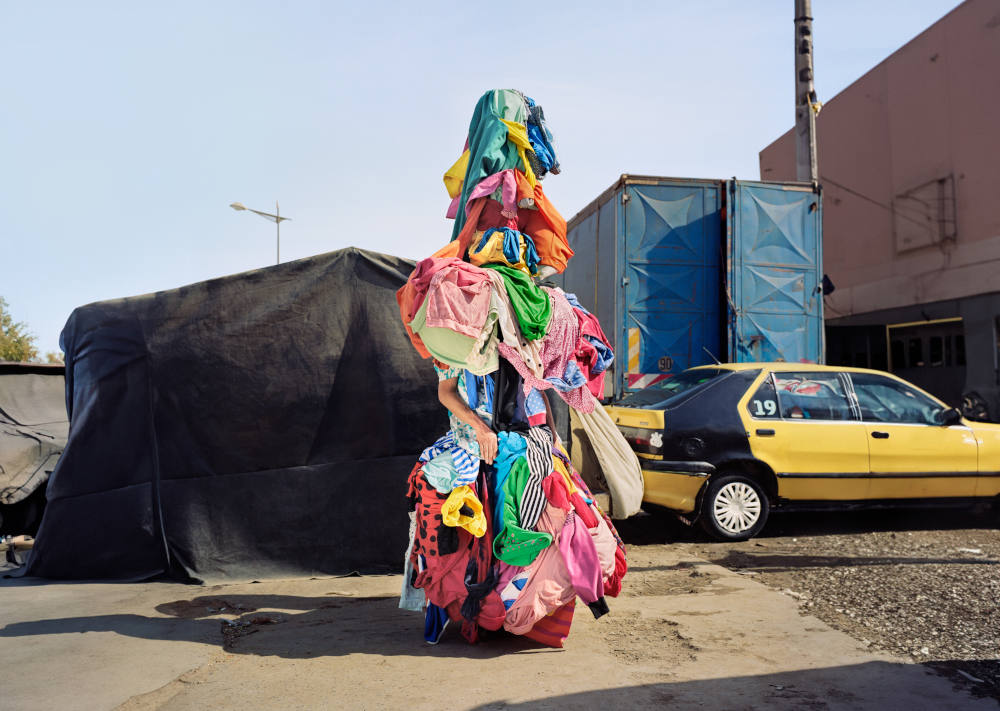
A creation of performance artist Jeremy Hutchison, the clothing "zombie" was seen walking around Manhattan during New York Fashion Week. The project aims to raise awareness about clothing waste in the fashion industry. (Dani Pujalte)
As an eco-conscious fashion enthusiast, I've appreciated fashion's nod to sustainability over the last half-decade, from the Met Gala featuring vintage dresses and others made from upcycled materials, to seasonal collections reflecting an eco-conscious mindset.
Fashion designers' interest and experimentation with eco-friendly fabrics was on full display this year during New York Fashion Week, with Christian Siriano debuting two looks made entirely of Circ Lyocell (a recycled textile). Other designers, like Kamal Haasan, featured runway pieces made of organic tomato leather and other repurposed textiles.
Despite these well-meant displays, fashion's sustainability track record as an industry leaves much to be desired.
Fashion fuels overconsumption through frequent trend cycles, with high fashion pieces inspiring cheaper simulacra that companies produce in the millions. Consumers cycle through these pieces to keep up with changing trends.
What's more, beloved fashion brands have had their fair share of environmental faux pas, with Coach and Burberry admitting to destroying tons of new stock.
Fashion's climate impact extends beyond incinerated clothes and slashed purses. Several studies have estimated the apparel and footwear industry is responsible for anywhere between 2% and 10% of global greenhouse gas emissions, the latter estimate surpassing emissions from the aviation and shipping industries combined.
Fashion's carbon footprint is complicated by major textile countries' reliance on coal, energy expenditures during production and shipment and heightened production output. The industry is also a major contributor to plastic pollution and water pollution. Though data is lacking on the exact size of the fashion and apparel industry, existing figures suggest that 80-150 billion new garments are made per year.
So while seasoned and emerging designers symbolize a potential sustainable turning point across the industry, fashion still has a way to go to truly go green.
These worrying features of the fashion industry reflect a broader, cultural devaluation of products, people and planet. Fanciful garb can easily distract from corporate shortcomings.
Yet one piece from this week put fashion's throwaway tendencies on full display. Some NYFW-goers found themselves face to face with a towering clothing pile, animated and ambling about Manhattan.
This 8-foot sartorial display, also known as the clothing "zombie," is the brainchild of U.K. performance artist Jeremy Hutchison.
Advertisement
The "zombie" is one of several wearable sculptures that Hutchison has made to address the rampant clothing waste generated by the Global North and foisted on the Global South. The sculpture is meant to resemble a pile of discarded garments, like those in the global trade in secondhand clothes. As the zombie, Hutchison is clothing waste personified.
Clothing waste is more than an eyesore — it poses great environmental and social problems.
In African countries like Ghana, textile imports from North America and Europe overwhelm local economies, communities and ecosystems. In Ghana, secondhand clothes are called obroni wawu — translated to "dead white man's clothes." Clothes resembling grandpa's closet, bearing political insignia and U.S. university logos, fray and rot on Ghanaian beaches, all while degrading land and water. Every well-meant clothing donation holds the potential to injure our neighbors across the ocean — and every new garment can easily become another castoff.
In the Catholic tradition, Pope Francis calls social tendencies toward devaluing people and planet a cardinal sign of "throwaway culture," where "what is (deemed) useless is discarded."

(Unsplash/Waldemar Brandt)
The pope wrote in his 2015 encyclical "Laudato Si', on Care for Our Common Home" that "our industrial system, at the end of its cycle of production and consumption, has not developed the capacity to absorb and reuse waste and by-products. We have not yet managed to adopt a circular model of production capable of preserving resources for present and future generations, while limiting as much as possible the use of non-renewable resources, moderating their consumption, maximizing their efficient use, reusing and recycling them."
In January 2023 during his Angelus prayer in St. Peter's Square, Francis extolled the value of treasuring God's creatures and creation, while noting how too many fail to do so:
Not wasting allows us to appreciate the value of ourselves, of people and of things. Unfortunately, however, this principle is often disregarded, above all in more affluent societies where the culture of waste and the throw-away culture are predominant. Both are a plague.
Francis' words reveal the great faults in our industrial system. Apparel corporations, among others, churn out stock with little interest in the consequences. And since companies have not compiled data on production numbers, addressing these harms concretely proves difficult.
With limited data available, corporations can feign ignorance. And with the injuries of throwaway culture concentrated in the Global South, North American consumers do not regularly face how their quick cycling through clothes and other goods harms God's people and planet — until now.

Pope Francis is accompanied by two children as he leads the Angelus from the window of his studio overlooking St. Peter's Square at the Vatican on Jan. 29, 2023. (CNS/Vatican Media)
Hutchison's clothing zombie forces a crucial encounter by reflecting corporate and consumer participation in overconsumption. As a stark reminder of the communities burdened by the Global North's greed and unbridled excesses, from Ghana to Chile, the clothing zombie puts throwaway culture on full display.
Hutchison's clothing zombie is a mirror, reflecting back at consumers the wounds wrought by foregoing the common good for self-interested ends. In this way, I find the zombie particularly spiritually confronting. (And perhaps I'm reading too much into it, but the zombie's form reminds me of a cross.)
From my vantage point, the zombie's confrontation contains an invitation: to follow in its (literal) footsteps.
In a 2023 collaboration with the Ghanaian-based organization The Or Foundation, Hutchison donned the zombie and took to the high streets of England to send a message to fashion's big producers. The zombie's trek promoted The Or's Speak Volumes campaign to pressure clothing companies to disclose their production volumes to gather more accurate data in tackling clothing waste throughout the supply chain. Hutchison-as-zombie clamored into stores and fashion headquarters, silently delivering physical letters urging brands to track their production outputs and tackle clothing waste.
In New York, these joint efforts continued, with the clothing zombie's presence promoting the campaign and pushing for disclosure data. Dancing in Times Square amid campaign billboards, the clothing zombie indicts preexisting consumption patterns, while inviting alternative actions from corporations and consumers to reach just, sustainable ends.
The Or's campaign urging is driven and determined: "If we are going to clean up fashion's waste crisis, develop data-driven policies and transition from a linear to a circular economy, we need to know how many garments are produced every year."
Their pressure campaign illustrates that all hope is not lost — but we must turn abstract ideas about sustainability, circularity and justice into a tangible reality.
Hutchison's clothing zombie sets us on a journey: to interrogate our impulse to discard and relegate products, people and ultimately the planet to the trash heap, and to set out on a more just path.
This performance piece also shows that within every clothing pile lies a message, if we'd only open our eyes and ears to it.






